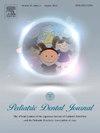Association between food difficulty and oral function in school-aged children
IF 0.8
Q4 DENTISTRY, ORAL SURGERY & MEDICINE
引用次数: 0
Abstract
Objective
This study aimed to investigate the relationship between children's subjective perception of food difficulty and the physical properties of foods, and to examine how these factors are associated with oral function development.
Methods
A questionnaire survey on “food difficulty” was conducted on 25 types of foods with 133 first-grade elementary school students (70 boys and 63 girls). The physical properties of the foods (hardness, cohesiveness, and adhesiveness) were measured. The masticatory difficulty score for each child was calculated by integrating texture values with their subjective evaluations. In addition, oral function measurements were conducted, including occlusal force, lip-closing strength, tongue pressure, masticatory performance, and masticatory path width. Associations between masticatory difficulty scores and oral function were analyzed using Spearman's rank correlation.
Results
Foods with higher hardness and cohesiveness were rated as more difficult to eat. Children who perceived hard and cohesive foods as difficult to eat tended to exhibit a lower occlusal force and reduced masticatory performance, suggesting an underdeveloped masticatory function. However, the association with adhesiveness was limited, indicating the potential influence of non-physical factors such as preference or food shape.
Conclusion
Children's subjective perception of food difficulty is closely related to food texture, particularly hardness and cohesiveness, and is associated with oral function development. These findings suggest that incorporating food texture into oral health assessment and dietary education is a beneficial approach, as it may help foster eating habits that promote the development of masticatory function in children.
学龄儿童进食困难与口腔功能的关系
目的探讨儿童进食困难的主观感知与食物物理性质的关系,以及这些因素与口腔功能发育的关系。方法对133名小学一年级学生(男生70人,女生63人)进行25种食物“进食困难”问卷调查。测定了食品的物理性能(硬度、内聚性和粘附性)。每个孩子的咀嚼困难评分是通过纹理值和他们的主观评价相结合来计算的。此外,还进行了口腔功能测量,包括咬合力、闭唇强度、舌压、咀嚼性能和咀嚼路径宽度。采用Spearman秩相关分析咀嚼困难评分与口腔功能之间的关系。结果硬度和黏结性越高的食物越难食用。认为坚硬和粘连的食物难以进食的儿童往往表现出较低的咬合力和咀嚼功能下降,表明咀嚼功能不发达。然而,与粘附性的联系是有限的,表明非物理因素如偏好或食物形状的潜在影响。结论儿童对食物困难的主观感知与食物质地尤其是硬度和黏结性密切相关,并与口腔功能发育有关。这些发现表明,将食物质地纳入口腔健康评估和饮食教育是一种有益的方法,因为它可能有助于培养促进儿童咀嚼功能发展的饮食习惯。
本文章由计算机程序翻译,如有差异,请以英文原文为准。
求助全文
约1分钟内获得全文
求助全文
来源期刊

Pediatric Dental Journal
DENTISTRY, ORAL SURGERY & MEDICINE-
CiteScore
1.40
自引率
0.00%
发文量
24
审稿时长
26 days
 求助内容:
求助内容: 应助结果提醒方式:
应助结果提醒方式:


